


GODDENDENE AND THE MARCH FAMILY
Goddendene, formerly known as ‘The Leys’, was a seventeenth century mansion once used as a coaching inn for the London to coastal towns route. It could be found in Farnborough Common (A21), Locksbottom, immediately adjacent to the Old Whyte Lion.
It was demolished in around 1978. and the grounds are now the location for Sainsbury's supermarket. The photo below was taken in 1954.
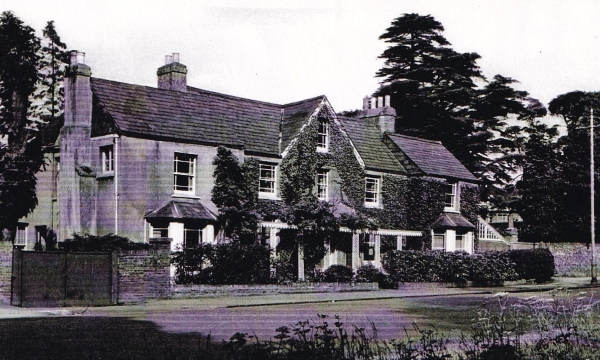
The Leys
The house, was much older than the first recording, of it. That appears in Strong’s Directory, of Bromley and District, for 1866, at which time it was name 'the Leys'. The occupant at that time was Mr Henry J.Latter, a London Merchant Banker. He also appears in the census of 1871,and 1881,with his Wife and four children, with two servants. He died on 9th January 1891,aged 69,and is buried at St. Giles Farnborough, together with his wife Maria who died just two months later.A seat in remembrance of Henry and Maria can be found in the Churchyard of St. Giles church in Farnborough, close to the war memorial, looking south toward High Elms. It is placed on a purpose made brick plinth in a flint lined cutting into the banking at the top end of the main churchyard.
|
|
|
|
|
From 1882 to 1894, it is recorded that Mr Charles Latter, was living at “The Leys”, presumably the son of Henry and Maria.
Over the next five years there are many residents recorded: In 1896, Mr H.P.Drayton, is resident. In 1897, A.H.Hoffman, Dr Surgeon, is in residence. 1898 records that Dr. Henry Johnstone, is in residence. Tragically this unfortunate man, committed suicide, here whilst he was suffering from 'a temporary mental breakdown', on Sunday13 January 1901.
Goddendene
The March family moved in later that year (1901), and renamed it Goddendene, They immediately set about transforming it into an extensive worksite for their artistic talents. George Henry March and his wife Elizabeth Blenkin had nine children, all of whom thrived in the space and facilities offered at Goddendene, and achieved, in some cases, world prominence.The March artists were widely known in their time. A black-and-white, silent movie was filmed in 1924 that explored the March artists at work in their studios at Goddendene.
This has been reproduced by British Pathé. View the video here Note that this site sometimes gives an error message suggesting that the video is not available. This is not correct, and refreshing the screen usually cures the problem - I suspect it is a slow website and just times out.
In 2011, an exhibition was held at the Bromley Museum at The Priory on Church Hill in Orpington. Featuring the work of local artists, the exhibit included scale models made by members of the March family.
The Studios
The first studio was built in 1902, with two more being added in 1911 and 1926. An account by a visiting Canadian in 1949 explained that two workshops were used primarily by Sydney and Edward, and the third by Elsie. He described the site as being crowded with work both completed and in progress - both of sculpture and of paintings.There were in fact around seven acres of studios and a mass of workshops including a casting pit, furnaces, a small railway, and a huge hoist for moving heavy materials. One of the studios was so high that the RAF brought their parachutes to there to dry. An unusual feature of one of the studios was that its walls were on rails. This meant that when the March’s wanted to view the large pieces of work in perspective, they could open the doors so leaving the models out in a large open space.
The casting shed had a huge pit in the ground lined with bricks where sculptures are put in to ‘cook’. The finishing shop had a gas engine in it. Edward March had fitted a hydraulic pump to the engine to help in the brazing and smelting of the item. Mr Edward March: ‘
We transformed the outhouses to make the works, and they have been the scene of our experiments, clouded in the early days with little failures, but ending ultimately with success. It was while we were in Kensington eight or nine years ago that I conceived the idea of carrying out our own casting. One could not get casting properly done. We experimented, and now, as you can see, we do it all ourselves.’ The Star, 8 January 1909.
A visitor to Goddendene in the late 1940’s described the walls as being covered with watercolours from Elsie’s prolific brush, as well as oils by herself and her brothers. ‘an artistic treasure house, where one can see art in the making’ Mr. C. Harold Hale 1949.
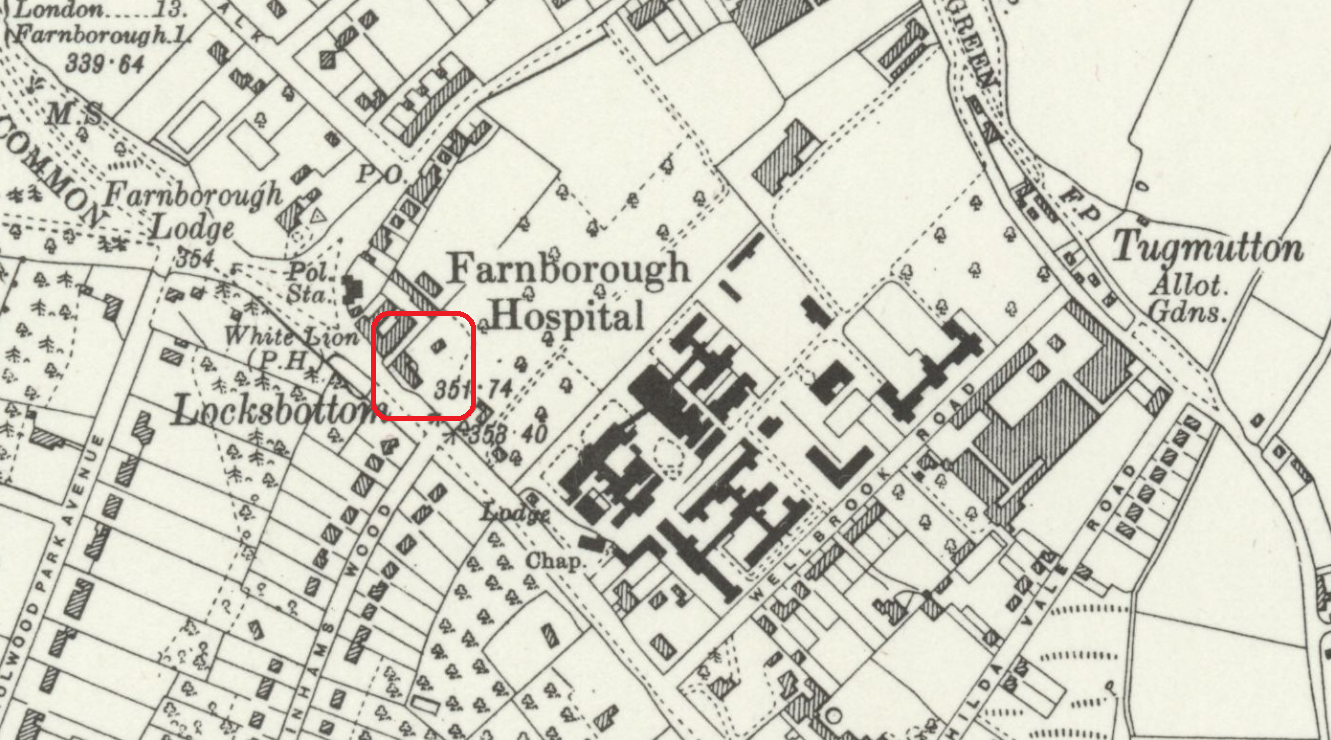 The location of Goddendene with studio at Locksbottom, click to enlarge |
The March Family
George Henry March and his wife Elizabeth Blenkin first lived in Stoneferry, a suburb of Kingston upon Hull, in the East Riding of Yorkshire.By 1901 they had moved to the house in Locksbottom,, and the entire family were living at Goddendene. Sadly George and Elsie both died in 1904. They are buried at St. Giles Farnborough, together with all but one of their offspring.
George Henry (1842-1904)
The Father of the March family, at the time of the 1891 census,he was a seed crusher foreman (oil miller)Elizabeth March (1846-1904)
The mother of this unusually talented family, she was the daughter of a Yorkshire farmer who was not encouraged in her talents, but was keen to inspire any of her children in this way. In the end all seven of her sons and one of her two daughters were talented artists. Sydney said of his mother: ‘She wanted to be an artist herself but her father would not allow it, and she had to content herself to music. But she encouraged any sign of an artistic tendency in her children, and some of us were drawing pictures when we were only five.’ London Express 1920’sTalented Children
Three of the March children became sculptors: Sydney, Elsie, and Vernon. The other five artists were Edward, Percival, Frederick, Dudley, and Walter. The ninth sibling was a sister, Eva. By 1911, all nine, as yet unmarried, were living together in the 17-room house "Goddendene" in Farnborough, Kent, England Only two of the March siblings married; between them, they had three children. Eva married Charles Francis Newman in 1916. [They had a daughter, Heather. Frederick March married Agnes Annie Gow in 1926. They had two children, Elizabeth and Cecil.What a family! Seven of them, all bachelors, and all living together at Farnborough, with their only sister, Elsie, also unmarried, to keep house for them.’ London Express 1920’s
It is extremely doubtful if - in the world of art, at any rate - a more wonderful family record can be shown than that of the March family, who live in a Kentish village. There are sewn brothers and one sister, and all of them are exceptionally clever in one or another phase of sculpture - and even pack their work themselves.’ London Express 1920’s. ‘
It would be difficult to find a family more united in the artistic temperament and the capability of giving it expression to a remarkable degree than the March family. Each member of the family has his or her particular work. Mr Edward March is a painter, designer and modeler. Mr Sydney March is a sculptor, Percival March and Harry March are modelers. Dudley and Walter March are metal workers; Walter March is a patina worker and completes designs. Vernon March is a sculptor, modeller.
They are all artists to their finger tips. The whole of the work, including the bronze-casting; is done in their large studios behind their home, for one or other of them is fitted by talent and training to execute details which, in the case of a sculptor with only one pair of hands, would have to be “put out”.’
Here are details for each of the march siblings.
Edward March (1873-1941)
Edward was the eldest of the family and established the March Brothers firm. He studied at the Hull Art School and the Royal College of Art at South Kensington. He helped his brothers in casting and sculptural works, but preferred painting portraits. His portraits include Lord Dunsany and the Marquis of Aberdeen. He exhibited at the Royal Academy. He died suddenly on 21 January 1941 and is buried in the family vault in Farnborough churchyard.Sydney March (1875-1968)
His sketches at the age of five showed great promise, and at thirteen he attended a school of art. He won prizes and a scholarship to the Royal Academy where he studied for three years. He had a studio in Chelsea for a number of years and exhibited regularly at the Royal Academy. His early commissions included a marble bust of King Edward VII for Windsor Castle. The King was so pleased with the result that he asked to meet the sculptor and said ‘He is a mere boy’. Later sittings included Queen Alexandra and the Prince and Princess of Wales. He set up a studio in 436 Avenue Road, Toronto, which was later taken over by Edward. He was the last of the brothers to die at the age of 92.Read More (Wikipedia)
Percival March (1878-1953)
Percival specialised in bronzes. He described himself as ‘an art craftsman’. He was a keen motorist and very interested in gardening. He died on 20 October 1953.Frederick Henry [Harry] March (1879-1962)
The only brother of the family to marry, to Agnes Gow. They had two children Elizabeth Eileen (Betty), who died in 1990, and Cecil./ Harry died on 2 November 1962 at Goddendene.Dudley March (1882?-1962)
Dudley trained as a goldsmith in London and had many commissions for jeweler that he designed and made himself. He was also a gifted metal worker and made many statuettes. He also exhibited at the Royal Academy. He spent much of his time whilst working at (Goddendene putting the finishing touches to works. His main interests were engineering and sailing. He died on 6 June 1962.Elsie March (1884-1974)
She was an accomplished sculptor and painter and a member of the Royal Society of British Artists, and exhibited frequently at the Royal Academy. In 1939 she made a bronze plaque of Christ & Apostles which was placed in Farnborough Church. Watercolour painting maintained Elsie in later life when she could no longer sculpt. Elsie died on 31 May 1974, and left an estate of £72,500 to her nephew Cecil Gow and niece Elizabeth Eileen and their cousin Heather Longly. Once asked why none of her brothers had married, she replied: I am their housekeeper, and I expect I look after them too well.’ The brothers confessed that they were very comfortable, but said they simply had not thought anything about marriage. ‘Our art occupies all our attention’ said Mr Sydney March.Read More (Wikipedia)
Eva March/Barker (1886-?0
The only daughter to have married - Mr Raymond-Barker - a teacher of mathematics. They had a daughter, Heather Longly, who in turn married and had a daughter, Sandra Spurr.Walter March (1888-1954)
Walter was an assistant sculptor and an artistic bronze founder. He supervised bronze casting and marble carving. He was a Lieutenant during World War I when he was workshop officer with the Royal Army Corps in Mesopotamia and Palestine. He died on 21 August 1954.Vernon March (1891-1930)
The youngest of the family, his simple little drawings at the age of 2 or 3 showed great promise. He never attended art school, but was trained by his brothers in a way no formal school could have done. At the age of 16 he exhibited a sculpture at the Royal Academy. In 1914 he won his first big competition to design and produce a statue of Samuel de Champlain in Orellia, Ontario, Canada.During World War I, Vernon joined the Royal Flying Corps as he had learnt to fly privately, but his poor eyesight prevented him flying for his country.
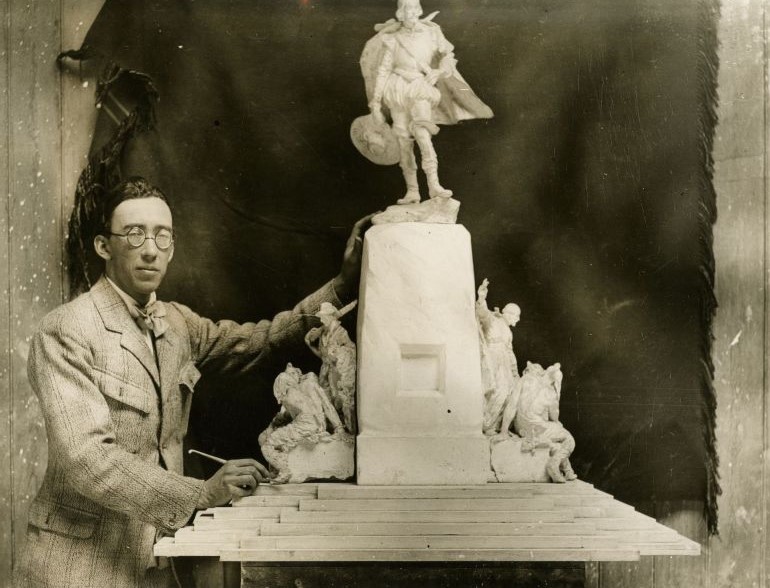
Vernon shared a studio in Chelsea with Sydney, where he did some very good watercolours of the River Thames and other peaceful landscapes. He was an accomplished pianist, but his main hobby was driving cars. In 1912 he raced at Brooklands and won. He also created pieces to modify his cars. He kept a car capable of doing 90 mph at Goddendene, in which he caught a chill which developed into pneumonia. He died aged 38 on 14 June 1930.
Read More (Wikipedia)
Sources, Bill Morton and Fred Whyler
The End of the Studio
Elsie was the last member of the family to live there. She passed the house to her nieces and nephew, but they left it empty. Thieves and vandals stripped part of the building. It was described as: ‘a rambling, snug, white walled, low ceilinged, old house.’On 23 February 1978, the local paper reported that the land was to be developed into a supermarket, with Goddendene being incorporated into the structure, or even being made into a restaurant. In fact it was destroyed by developers overnight with no notice being given.
While of historic note the house was not listed so not subject to legal protection
This heralded the end of an era for the historic home of a talented and world famous family.
The supermarket was of course the Locksbottom store of Sainsbury's, although they were not the original developer. The pedestrian entrance for the supermarket from the main A21 passes over the former location of the house.

The nine March siblings pictured with their parents' work on plaster marquets, which formed the basis of a statue now in Omagh, Ireland. The marquets were still standing in a workshop at Goddendene when the bulldozers arrived. They had been standing there for about sixty years.
.
LOCKSBOTTOM
The number of commissions completed by members of the family in all parts of the world is too extensive to reproduce here, but two are of particular mention, one because it is of local significance, and the second because it is their most famous work.
Bromley War Memorial,
Situated at the top of the hill in St Martin’s recreation ground, was unveiled on 29th October 1922 by Lord Horne, G.C.B., K.C.M.G. and dedicated by the Bishop of Rochester John Reginald Harmer DD.The Portland stone pedestal is 27 feet 6 inches high. The three figures in cast bronze represent “Victory” in the front, “Liberty” on the left and “Sorrowful Remembrances” on the right. The memorial was designed and modelled by Sydney March, sculptor, and the bronze castings were executed by Messrs March Bros. of Farnborough.
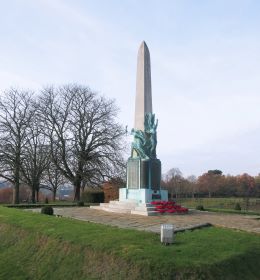
There are four main panels in bronze with a total of 858 names raised in letters. An additional panel with 14 names was added at a later date. In 1949 side panels were added to commemorate the fallen of World War 2.
The Canadian War Memorial
When in 1926 it was decided that Canada should have a memorial of her own in her capital city, architects and sculptors were invited to submit designs.One hundred and twenty three entries were received among them was that of Mr Vernon March. He heard on his wireless that a Kent sculptor had won an international competition for the Canadian National War Memorial. He and his six brothers and their sister at once set to work on the ‘full scale design.
In 1930 tragedy overtook the family for Vernon March died. the work however went forward ,and the brothers and sister, basing their labours on the small soft clay model made by their brother. It is now kept under a glass case in order that all who visit their home in Kent may see the true inspiration of the beautiful memorial.
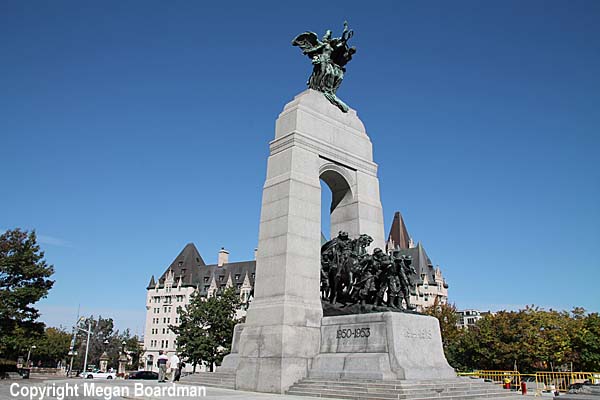
“Triumph of Peace Over War”.
When completed it was erected temporary in Hyde Park, London. Consisting of a tall granite arch, surmounted by huge bronze figures of liberty and victory, the 90ft,high memorial symbolises the triumph of peace over war. At the base of the arch are 22 figures representing every branch of the war service hurrying towards the new Dawn and leaving behind the man unlimbered gun. The only inscription on the memorial is simply “1914-1918”.
Many distinguished Canadians , among them Mr Mackenzie King, and Mr R.B.Bennett, have visited the March Brothers workshop and have expressed their appreciation of the work.
The figures was erected in 1928, and was at the time the largest war memorial in the world. It was unveiled by King George VI.
A Visit to Goddendene
The following extract referring to a visit to the home of the March family “Goddendene” Locksbottom, Farnborough, Kent. was included in a Canadian Booklet.“Seven Weeks of Sightseeing in England and Wales” a selection of articles contributed to the; Orillia Packet and Times, written and published by Mr C. Harold Hale.On Bank Holiday, the first Monday in August, the Veugens drove us down to Canterbury, to see the cathedral, central shrine of Anglicanism.
On the way we dropped in at Goddendene, the home of the March family at Farnborough in Kent. We were given a hearty welcome, and spent a couple of hours most enjoyably viewing the varied artistry of that talented family.
There are three separate studios, two those of the brothers Sydney and Edward March, and the third that of the one sister, Miss Elsie March.. They are crowded with their work, completed and in process, both in sculpture and in painting.
Following the last war there has not been the demand for statues and sculpture that there was after the Great War, and Mr. Sydney March is now devoting his attention largely to portrait painting in oils. But he has some very fine sculpture in his studio, among others a lifelike bust of Winston Churchill and an excellent and readily recognisable three-quarter length bust of Lawrence of Arabia, in his sheik’s garb.
We also saw the original model for the Champlain monument, and examples of the early work of Vernon March, its designer. His genius began to develop in boyhood. Among the things we were shown was a small statuette he produced at eleven years, and another excellent one at seventeen; and some oil paintings he had done. Vernon March’s untimely death at age 35 was a tragic loss to the world of art. Orillia has reason to be proud that this town has his master-piece.
We were surprised to find how few of our friends were familiar with the art of the Marches though four of them have had specimens accepted for display at the Academy. “Now it can. be told” I may reveal that when I sent a photograph of the Champlain monument to the Illustrated London News, for use following the unveiling, it was “Returned with thanks.” Thus a journal which prides itself on its artistic acumen turned down the opportunity to print an early picture of the monument which is- now widely acclaimed as one of the finest examples of bronze statuary on the American continent.
Other papers throughout the Empire showed better judgment and were more appreciative, including the London Times. And on this continent the press generally, both in Canada and the United States, appeared to realise ‘they had been offered something worth while’, and featured pictures of the monument, of which there is evidence in the scrap book reposing in the Public Library.
This is a digression from a description of our visit to Goddendene. In the old fashioned and roomy home itself, over which Miss Elsie March presides with charming hospitality, the walls are covered with water colours from her prolific brush, varied with oils by herself and her brothers. It is indeed an artistic treasure house, where one can see art in the making.
Both Miss March and Mr. Sydney March assured us that any Orillians who might be visiting England, and cared to run out from London to Farnborough, a matter of about thirty miles, would be most welcome.
We can assure any of our readers who may have the opportunity that it is a trip that will well repay the time and trouble.
Family Burials in Farnborough
George and Elizabeth are buried in a large double grave in the churchyard at St. Giles church in
Farnborough, as are all but one of their offspring. The exception is Eva who moved away from the area. Interred in the same grave is Elsie's nephew Cecil, who inherited the house when Elsie died.
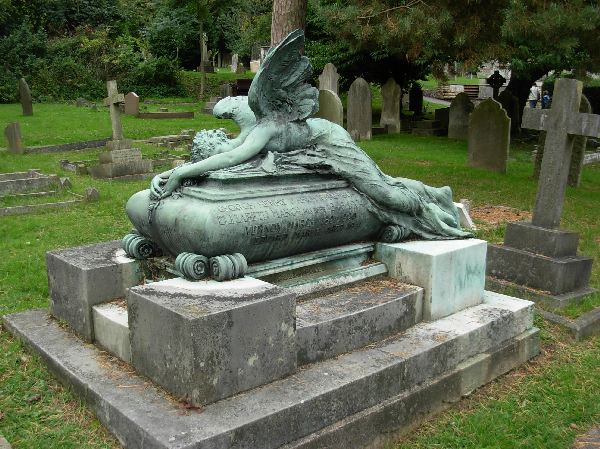
The elaborate monument for the family grave was sculpted in bronze 1922 by Sydney March